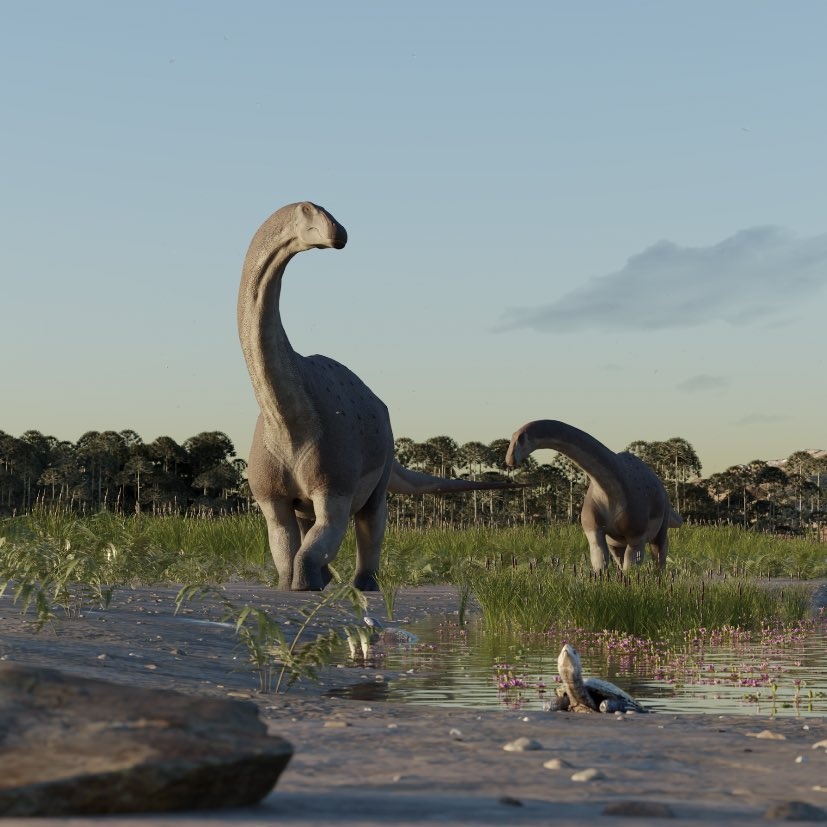Buenos Aires. Paleontologists from the National Council for Scientific and Technical Research (Conicet) of Argentina discovered in the south of the South American country the remains of a titanosaur that lived 66 million years ago, the scientific organization reported today.
Official information revealed that the species, called Titanomachya gimenezii, It is a new titanosaur that is estimated to have weighed about 7 tons and that lived in Argentine Patagonia around the end of the Cretaceous period.
The discovery took place in the La Colonia formation, in the province of Chubut (south), and was reported this Thursday in the scientific journal Historical Biologysaid Conicet, which also noted that “the discovery opens the door to future research that delves into the diversity and evolution of these majestic giants.”
“The extraction process was very meticulous and involved 10 people, since it required ’emboting’ or covering the remains with burlap cloth shirts and plaster to protect them before their transfer to the laboratories of the Egidio Feruglio Paleontological Museum (MEF)” reported Agustín Pérez Moreno, Conicet postdoctoral fellow at the Museum of the city of La Plata and first author of the work.
The researchers recovered elements of the forelimbs and hindlimbs, fragments of ribs and a caudal vertebra.
“Small, if compared to other giants found in Chubut, such as Patagotitan mayorum, which was estimated to be almost 40 meters long, with a neck of 12 meters and an estimated weight of 70 tons, ‘T. gimenezi’ is the second dinosaur found in the La Colonia formation and the first sauropod, that is, belonging to the group of the largest terrestrial vertebrates in evolutionary history characterized by being herbivorous,” explained Conicet.
Pérez Moreno pointed out that the La Colonia formation “is known for having revealed various fossils, from carnivorous dinosaurs and plesiosaurs to turtles and other reptiles.”
“The findings in La Colonia not only offer crucial information about sauropod populations in Patagonia during the end of the Cretaceous period, but also about the diversity of the region’s ecosystems at that time,” the researcher noted.
Conicet mentioned in its statement that the species found inhabited Patagonia (southern Argentina) during the Maastrichtian, the last age of the Cretaceous period that preceded the mass extinction of dinosaurs.
“The environmental reconstructions of the La Colonia formation indicate that at that time these environments were dominated by estuaries or lagoons, that is, that their environment had a varied flora that included palm trees, aquatic plants with flowers and conifers,” detailed the information from the organization. scientist.
Pérez Moreno considered that the discovery “adds a new perspective to the rich history of the sauropod dinosaurs of Patagonia during the Upper Cretaceous and opens the door to future research that delves into the diversity and evolution of these majestic giants.”
According to Conicet, the name that the authors gave to the new copy evokes the Titanomachy, the battle that, in Greek mythology, was fought by the Olympic gods against the titans, in which they were finally defeated.
“This name is especially appropriate, since ‘T. gimenezi’ comes from the time when titanosaurs became extinct,” Pérez Moreno highlighted, adding that “with the word ‘gimenezi’ we pay tribute to the late scientist Olga Giménez, who “She was the first paleontologist to study the dinosaurs of the province of Chubut. Her legacy has left an indelible mark, and this designation seeks to honor her pioneering contribution to the understanding of the rich paleontological history of the region.”
#Remains #titanosaur #discovered #southern #Argentina
– 2024-04-26 20:53:55
